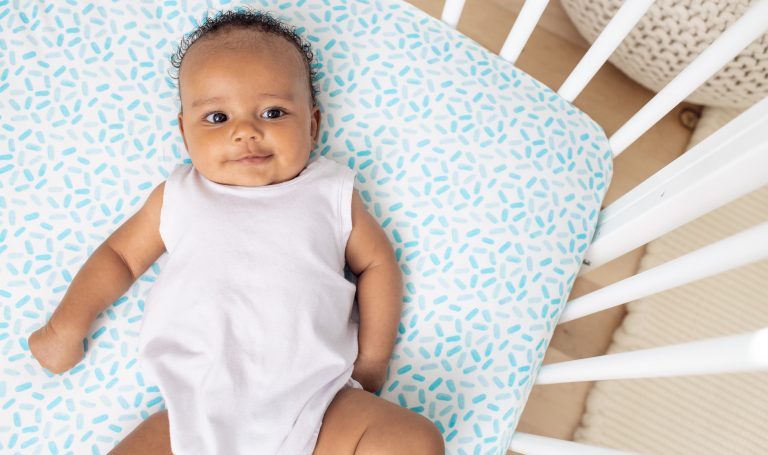5 fun ways to play with your baby from 4 weeks to 12 weeks old

Your sweet newborn is fed, rested, and alert. Now what? 🙃 Here are some easy ideas for your baby’s first playtimes.
Hand discovery
You can get black and white patterned mittens in the first Play Kit or make your own by putting a piece of cloth with a black and white design tied loosely around your baby’s palm.
- Lay your baby on a plain blanket without other objects to distract them.
- Place the black and white mittens on your baby’s hands while they’re lying on their back, side lying, or during tummy time.
- See if they start to notice their hands ❤️
Paper play

- Babies are fascinated by paper ❤️ Tear a piece of paper in front of your baby’s view and watch them startle and focus on the sound.
- Slowly crumple up a piece of paper in front of your baby, showing them how it changes from a flat sheet to a crumpled ball.
- When your baby starts waving their arms (around 9-11 weeks)—and before they can coordinate grasping and getting objects into their mouth—try giving them a large piece of tissue paper. Position the paper so your baby can potentially hit it with their arms or feet; see if they notice the sound the paper makes when they accidentally hit it.
Real-life cause and effect with balloons
- Use a Sharpie and create your own high contrast design on a white balloon to capture your baby’s attention.
- Try batting a balloon in front of your baby and watch them try to track it; your baby will likely begin to track a moving object with their eyes at about 5 weeks old.
- Loosely tie balloons to your baby’s legs and see if they notice the movement when they kick.
Sound tour

Understanding that objects and people can make sounds is an early lesson in real-life cause and effect.
- Go on a sound tour of your house and see if you can get your baby to tune into the sounds of your daily life: your fingers rapping on a window; the doorbell ringing; a hairdryer; the beeping sounds as you press the buttons on the microwave, etc.
- Talk about what your baby is experiencing as you go.
Talking and reading

Talking with your baby is one of the very best things you can do to help build their developing brain. The more you talk with them, the more they understand—and the more they’ll eventually learn to say on their own.
Here are some tips for talking to your baby:
- Stick with it: your baby is processing what they’re hearing even if they don’t seem to be listening to you.
- Speak to them directly when you can: face-to-face conversation is the most helpful kind.
- Introduce your baby to a variety of words.
- Speak to them in the high-pitched, sing-song voice that comes naturally when speaking to babies.
- Use a book with high contrast images, like the Wooden Book in the first Lovevery Play Kit.
- When your baby makes a sound, reinforce it: mimic it back to them, then pause and make the same sound again—this introduces your baby to the back-and-forth rhythm of conversation.
- Don’t pressure yourself to talk constantly—just 15 minutes per waking hour can make a big difference ❤️

The Looker Play Kit
Designed to help your newborn begin to work on processing the new world around them.
Learn moreKeep reading

0 - 12 Weeks
3 - 4 Months
5 - 6 Months
Lovevery Announces New Parent Courses for Informed, Confident Parenting
Parenthood is filled with questions. Lovevery’s Parent Courses bring answers: with practical, hands-on tips for your most common parenting challenges in the first year.

0 - 12 Weeks
3 - 4 Months
5 - 6 Months
7 - 8 Months
9 - 10 Months
11 - 12 Months
0 - 12 Months
The complete guide to baby development milestones
We compiled this expert guide to help you know what to expect for your baby's growth and month-by-month development.

0 - 12 Weeks
3 - 4 Months
5 - 6 Months
7 key elements to create a Montessori nursery
A Montessori-inspired nursery is simple and soothing. We've collected 7 of our favorite items here to help you design one that's right for your baby.
